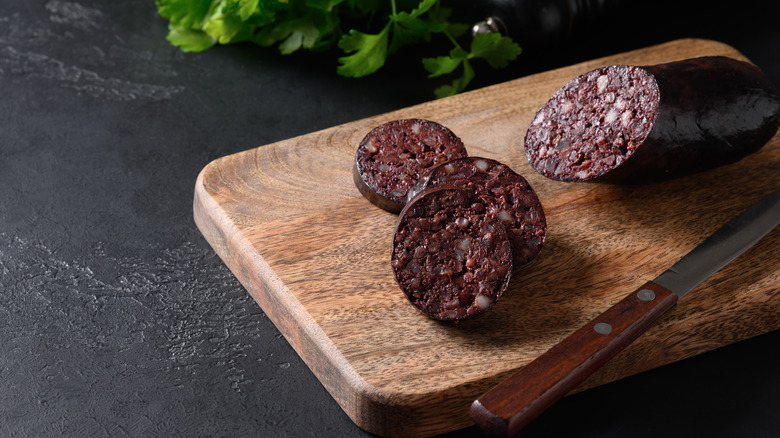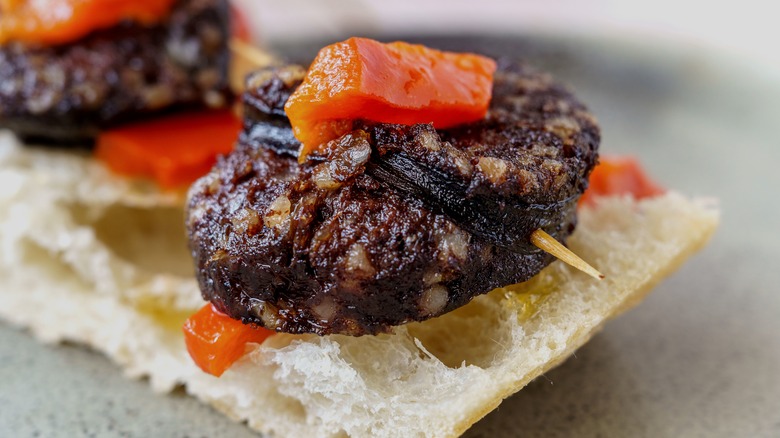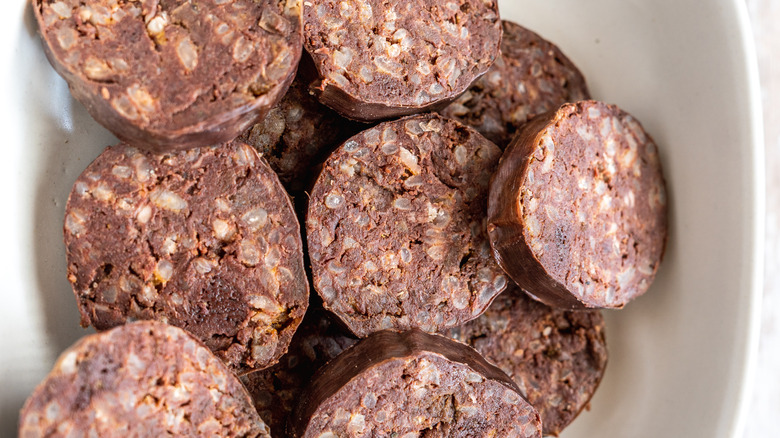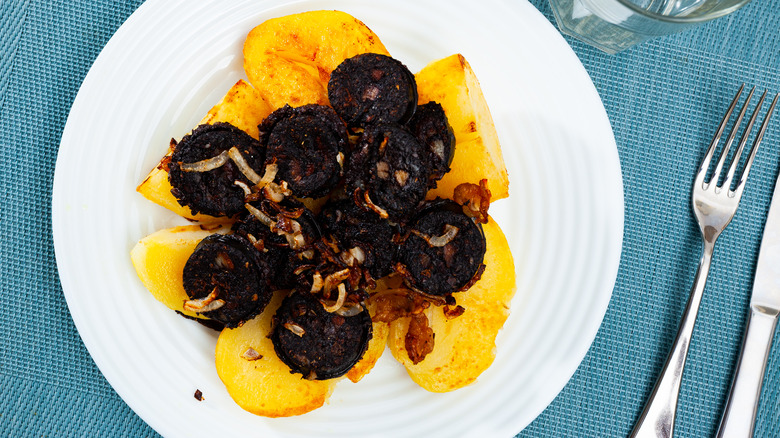What Makes Spain's Morcilla Sausage Unique
We may receive a commission on purchases made from links.
Sausages — a dependable meat product that just always hits the spot. From aromatic, herb-filled Laos sausage to fuss-free DIY breakfast sausage, there's a whole range of ways to eat meat in tube form. Humans caught onto the charms of this technique long ago, with the first mention occurring in a Greek play in 500 B.C. In addition to its possibility of tasty flavors, the sausage's versatility explains its enduring popularity. The tubed preservation not only melds delectable flavors but also preserves intestine, blood, and other offal that's normally wasted and makes them suitable for consumption (via Sausage House).
Blood sausages are a whole subclass of casing-bound food, with many varieties found worldwide. Throughout all of Spain, the star of the sausage show is morcilla. A deeply colored and rich food made with pork blood and spices, it's a unique sausage worth seeking out (via Feast Magazine). Let's dive into what makes it so special.
What is morcilla?
Morcilla, a variety of blood sausage, is made with pig's blood, seasonings, onions, and often ground pork and rice. Interlinked with the ritual of slaughter, it's a delicious method of utilizing every part of an animal. The sausage has a dark purple hue, with a dense texture and rich flavor, varied by region due to the addition of various fillers and spices. In Valencia, it's the spiciest sausage, while in central Spain, the absence of filler creates a creamy and smooth rendition. Through all of the interpretations, the unifying ingredients are the casing, and the addition of blood, notes The Spruce Eats.
Typically, the sausage is simmered in water and then cured, although, in Seville, it's even eaten raw. Once purchased from a butcher, most Spaniards then fry the sausage and serve it with bread and potatoes. It's also commonly added to various stews, and used as a stuffing for seafood like squid, notes Culture Trip.
How to prepare morcilla
Prepared soon after the butchering of a pig, morcilla relies on several cups of fresh blood. The liquid is combined with pre-cooked white rice, as well as spices, garlic, and other regional variations. After being mixed together, the thick substance is funneled into sausage casings made from the pig intestine. The resultant morcilla is boiled for around half an hour, after which it's ready for storage. Most often, the boiled sausage is cut into pieces and fried right before consumption, notes Amigo Foods.
Morcilla's preparation alters based on additions. For example, My Recipes' version uses duck fat to caramelize onions and garlic with paprika before adding pork belly cubes into the mix — rendering a chewier texture. To ease the stuffing procedure (the trickiest step of making sausage), the recipe recommends using the back of a wooden spoon to force the pork belly through the casing. Alternatively, food blogger Ben Wilder vacuum seals the morcilla before freezing it and then cooking in sous vide to preserve the casing. With so many morcilla variations, different sausage-making techniques can achieve a tasty result — just make sure it includes blood.
Variations of morcilla
The most iconic version of blood sausage comes from Burgos, a city in North-Central Spain. Filled with rice, this morcilla doesn't have any meat; instead, it's reliant upon a famed local onion for its flavor (per Meats and Sausages). In Andalusia, it's all about aromatic components, with the inclusion of cinnamon, cloves, and spice. And the differences aren't limited to stuffing ingredients — in Asturias, the sausage is smoke-dried. In part, such a range of preparations is due to morcilla's etymological origins. According to Jeffrey Weiss, author of "Charcutería: The Soul of Spain," the word initially references all kinds of sausages, not only the ones including blood. Such a lineage of linguistic history explains the lard-stuffed morcillas prepared sans-blood in remote parts of Spain, notes My Kitchen in Spain.
A menu staple, expect to find morcilla served for lunch or dinner across Spain. And the sausage's size varies — slender or thick, it'll be a satisfying inclusion in a meal (via Food Republic). If looking to purchase in the U.S., head to a Spanish grocery or order online.



